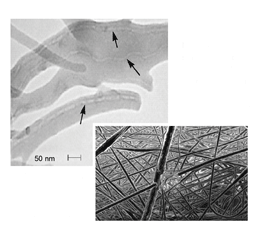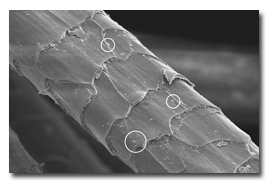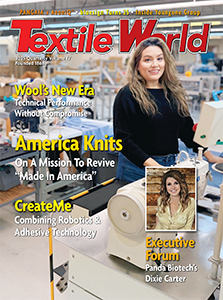N
anotechnology in its various iterations would seem to hold the promise of being the miracle
cure for many of the worlds problems. In the world of textiles, it may be used to change the
behavior of fibers and fabrics by incorporating performance characteristics into them without
changing the hand or other intrinsic properties of the material. Such characteristics include
stain-resistance and release, moisture-wicking, antistatic, and antimicrobial properties
characteristics traditionally added to fabrics by the use of coatings, which can wear off and so
are not as durable.

causes spilled
wine to ball up and roll off the fabric instead of being absorbed, as in the tie on the
left.
There also are more highly technical applications, as when carbon nanotubes are assembled into
yarns or sheets or incorporated into a polymer matrix to add strength, dimensional stability and
conductive properties. Nanofibers may be produced to make a nonwoven substrate, such as a tissue
scaffold on which to grow new skin, or for numerous other applications including filtration,
composites, wipes, radio frequency identification and protection from chemical and biological
agents. Some of these developments have been reported in past issues of
Textile World
.
A growing number of products are touting the benefits of nanotechnology, but its
environmental, health and safety (EHS) implications are not always well-understood. Concerns about
the possible risks from exposure to nanomaterials have led to calls for the development of criteria
and test methods to analyze the EHS effects of manufacturing processes, wearing off or degradation
of these materials, absorption into the skin, and other issues; and some guidelines while still
works in progress are now emerging
(See sidebar).
What Is Nanotechnology?
Nanotechnology has become a popular term that is sometimes improperly used to differentiate
products and technologies from their competition. Companies may boast of working at the molecular
level to produce their specialized products, and, indeed, nanotechnology does involve
molecular-sized materials, but not all work at the molecular level necessarily involves
nanotechnology.
“Everything ultimately works at the molecular level for example, wrinkle-free resins using
small-molecule chemistry that cross-links cellulose and makes it wrinkle-free. Thats not really
nanotechnology based on the definitions of the National Nanotechnology Initiative (NNI) or ASTM
International,” said William Ware Jr., senior vice president, research and development, at Oakland,
Calif.-based Nano-Tex Inc. “Its a constant battle. Theres lots of stuff out there and people are
talking nanotechnology without much pushback.”
The NNI a federal research and development program established in 2001 to coordinate the
nanotechnology-related activities of 26 federal agencies defines nanotechnology as “the
understanding and control of matter at dimensions of roughly 1 to 100 nanometers [nm], where unique
phenomena enable novel applications.” To be true nanotechnology, materials behave at the nanoscale
1 nm equals 1-millionth of a millimeter in ways not observed at a larger scale, and those behaviors
enable new applications that would not be possible at a larger scale.
According to Daniel J. Hayes, Ph.D., director of operations and a founder of NanoHorizons
Inc. a State College, Pa.-based company established in 2002 to develop solutions based on
nanotechnology licensed from Pennsylvania State University materials engineered at the nanoscale
are engineered to have a particular property or for a particular reason. In his view,
nanotechnology is focused more on material synthesis than on, say, molecular biology, biochemistry
and related fields.
Less Is More
Exemplifying the idea of “less is more,” nanosized materials offer more surface area relative
to their volume than larger materials a factor that enables more benefit to be derived using less
material, which also translates into cost savings. For the sake of commercial viability, the
technology should allow processing on conventional machinery.
Part of the trick to getting application of these technologies into fabric is to make the
system work in the conventional textile industry today, Ware said. We’ve been able to do that so
you don’t need to buy new equipment. Its all water-based and safe for workers, the environment and
consumers; and the costs are reasonable.
Nano-Tex founded in 1998 to develop consumer-focused textile applications using
nanotechnology, and the first company to offer such solutions to the textile industry currently
offers four “nanofinishes” for a range of natural and man-made-fiber apparel, home textile and
upholstery fabrics: Resists Spills; Repels & Releases Stains; Resists Static; and Coolest
Comfort moisture-wicking.
Ware said the finishes are “smart” polymer systems that provide better benefits using less
material than traditional fabric treatments. ‘We get them to behave so that they self-assemble on
the surface and make essentially a monolayer on the surface. The nanoscale is the thickness of that
layer definitely less than 100 nm and generally less than 50 nm. The polymers are permanently
chemically bonded to the surface of the fiber. ”
The Nano-Tex finishes are applied to processed fabrics rather than integrated into the fiber.
“From the processing standpoint it makes much more sense to do it at the fabric stage,” Ware said.
“We’re modifying the surface of the textile. If done in fiber form, that finish needs to be
compatible with all the other things that need to happen in fiber processing to make the process
easier. Its much cleaner to do it at the end.”
In the case of NanoHorizons’ SmartSilver antimicrobial treatment, silver nanoparticles
measuring less than 15 nm in diameter and added at the fiber stage provide the performance. “The
nanoparticles are in a form that can be added during polymer extrusion, or they are formulated in
the same way as a dye for natural fibers,” Hayes explained. The silver is covalently bonded
permanently to natural fibers at the same reactive sites to which dyes attach.
In addition to treatments for man-made fibers including nylon, polyester and polypropylene;
cotton; and rayon, the company has developed a treatment for wool the first permanent antimicrobial
treatment, it claims, for that fiber.
Arch Chemicals Inc., Norwalk, Conn., optimized its Purista® polyhexamethylene biguanide
(PHMB) antimicrobial treatment long established in nontextile applications such as swimming pool
sanitizers, contact lens solutions and medical products for apparel and home textiles that are at
least 35-percent cotton or rayon. Scott Brown, US technology manager, said Purista is ionically
bonded to the fiber molecule.
“There are multiple binding sites on each molecule, so you get very tight affinity,” Brown
said, “noting the very uniform and efficient distribution of the antimicrobial across the treated
fiber increases the probability that a microbe will come into contact with the agent. In contrast,
antimicrobial agents that are applied in the form of relatively large particles are at a
disadvantage in terms of microbial control, simply due to the reduced probability of microbial
contact with the agent.”
The academic community has served as an incubator for numerous nanotechnology advances. Once
developed to a certain level, these technologies may be licensed by private companies such as
NanoHorizons, as noted above, and Research Triangle Park, N.C.-based LaamScience Inc., to be
further developed for commercial viability. LaamScience established last year to license
light-activated antimicrobial nanotechnology developed collaboratively by Stephen Michielsen,
Ph.D., associate professor at North Carolina State University’s (NCSUs) College of Textiles,
Raleigh, N.C.; and Igor Stojiljkovic, Ph.D., and Gordon Churchward, Ph.D., associate professors at
Atlanta-based Emory University’s School of Medicine now is developing product prototypes for a
range of applications.
In explaining the technology, Michielsen, who also is chief scientist at LaamScience, said a
1- to 10-nm-thick surface treatment is covalently bonded to fiber surfaces. When exposed to light,
the material acts as a photo catalyst to cause a chemical reaction on the surface that is toxic to
microbes but harmless to humans. Michielsen said the finish is durable and continually regenerates.
Activating light sources include typical indoor lighting as well as sunlight. The bonding process
varies depending on the fiber, which could be man-made or natural.
The technology, unlike most other antimicrobial technologies, is particularly effective
against viruses and has potential day care, nursing home and hospital applications, among others.
“In the case of a major flu outbreak, this could potentially reduce the spread of infection by
reducing the active virus that people inhale,” Michielsen said.
One ongoing project at NCSU involves the use of nanofibers to make nonwoven tissue scaffolds
for wound-healing applications. Russell E. Gorga, Ph.D., an assistant professor at the College of
Textiles, is using the electrospinning process to create the scaffolds from a polymer solution with
carbon nanotubes added in to provide conductivity and structural support.
“We wanted to make a conductive scaffold so that when we seeded the scaffold with cells, we
could put a potential across the scaffold to try to induce cell differentiation and growth. We also
thought we could give structural support to the scaffold itself because the nanotubes have very
high moduli,” Gorga explained.
The 10- to 15-nm-diameter nanotubes also provided unexpected perks. “If we put nanotubes in
the solution, we get a much finer, thinner fiber structure, and we get more porosity so when we
seed the scaffold with cells, the cells grow much better than they do in the same scaffold without
the nanotubes,” he said, adding that he now is designing electrical stimulation experiments to
enhance cell differentiation and growth.
Gorga also is working with a scientist who can make nanotube yarns. “I have a student who is
looking at putting the yarns into composite structures and looking at the properties compared with
conventional carbon fibers,” he said. “We’re definitely excited about the potential to make really
nice carbon nanotube yarn, and about some of the potential things we could be doing there.”

left) from a polymer solution that contains carbon nanotubes, indicated by arrows, that
provide Conductivity and structural support, and improve the scaffold’s porosity.
Risk Assessment
It seems that most of the EHS issues surrounding nanotechnology involve applications other
than textiles, but the possibility exists that nanoparticles may be absorbed through the skin, with
carbon nanotubes receiving more attention than most other nanoparticles in this area; and there are
questions also about airborne and waterborne particles.
Acknowledging the state of flux related to the determination and management of nanotechnology
risks, Hayes believes there is no all-encompassing method of assessing the safety of nanomaterials.
“While nanomaterials present some new and unique phenomena, for the purposes of environmental
health and safety, a lot of the existing tests are still applicable. Nanomaterials are not by far
the smallest entities that are routinely tested and used in everyday life,” he said, pointing out
antibiotics, dyes and textile finishes as smaller materials.
“All nanomaterials are not created equally, and every nanomaterial has to be evaluated
individually and in the context of its use patterns,” Hayes continued. “If its carrying a drug that
is critical for treating a disease that is not treated in any other way and can move it across the
blood-brain barrier, then its very valuable. But when it ends up in places in the environment where
its not supposed to be and harms animals by the same action, obviously its not valuable.”
Michielsen would seem to concur with Hayes regarding nanotechnology risk assessment, at least
where LaamScience is concerned. “Most materials we use are food additive-type materials,” he said.
“Because we’re chemically bonding our treatment to the surface, we don’t have the potential of
passing between the cells of the skin, because the entire fiber would have to do that.”
Purista’s treatment has long been considered environmentally safe, according to Brown, who
said processing liquid unused at the end of the day is used the next day. Whatever PHMB is released
into the environment via wastewater binds to soil or sewage solids. “At that point, it has no
environmental impact,” he said.
As for concerns about carbon nanotubes in tissue scaffolds, Gorga said the nanotubes, which
are rigid rods, are locked into the polymer in his tissue scaffolds. Even so, he is working with a
toxicologist to assess potential harmful effects. He also said NCSU is considering establishing a
center to evaluate nanoparticle EHS.
“We can make scaffolds that wont biodegrade, so the nanotubes would be trapped and would not
leach out. Were talking about very low levels of concentration, embedded in a plastic substrate
thats not leachable,” Gorga said.
But the broader issue is we do need to think about EHS issues and address them in a more
rigorous, fundamental research manner, he added. Ware said NanoTexs polymer systems do not present
the same issues as nanoparticles. “Polymers, which are bound together, have a much better safety
profile than nanoparticles, which are much more of an unknown. Polymers are inherently bound to the
surface of the fiber and become part of the textile.”
In addition, he said, “they use a lot less chemistry [material] than conventional
technologies, so they’re inherently better from the environmental standpoint, and they use less
energy. From the worker safety standpoint, whenever we develop products we go through a full EHS
protocol.”
In the end, he said, “our name is on the end product, so its got to be safe.”

to provide antimicrobial protection. Above, nanoparticles are shown covalently bonded to
wool fiber.
Nanotechnology Risk Assessment:
Some Emerging Resources
issues related to possible benefits and risks of environmental exposure to nanomaterials. While not
making any final determination of such benefits or risks, the document does call for an approach to
assessing them that would evolve in response to continuing innovations in nanotechnology.
www.epa.gov/ncer/nano/publications/
The National Institute for Occupational Safety and Health (NIOSH) of the Center for Disease
offers a number of resources concerning the occupational safety and health issues related to
nanotechnology. “Progress Toward Safe Nanotechnology in the Workplace,” details work conducted by
the NIOSH Nanotechnology Research Center from 2004 through 2006; and the institute’s draft
“Approaches to Safe Nanotechnology: An Information Exchange with NIOSH” makes recommendations with
regard to safe practices in the workplace and seeks public comment for further understanding of the
relevant issues.
www.cdc.gov/niosh/topics/nanotech/
The National Nanotechnology Initiative also offers a number of resources including articles
and reports it has prepared as well as links to other publications, database resources and general
information.
www.nano.gov
West Conshohocken, Pa.-based ASTM Internationals Committee E56 on Nanotechnology has released
its first standard: E 2456, Terminology for Nanotechnology, and is developing others related to
properties characterization and EHS issues including WK 8985, Standard Guide for Handling Unbound
Engineered Nanoparticles in Occupational Settings.
www.astm.org
New York City-based Environmental Defense and DuPont, Wilmington, Del., are developing “A
Framework for Responsible Nanotechnology” to provide a system for assessing possible EHS risks
related to nanoscale materials used in all application areas, and for documenting and communicating
methods and parameters to address those risks. The final framework is expected to be released this
summer.
www.environmentaldefense/go/nano/
The International Council on Nanotechnology (ICON), based at Rice University, Houston, and
the universitys Center for Biological and Environmental Nanotechnology have launched a monthly
Virtual Journal of Nanotechnology Environment, HealthandSafety (VJ-Nano EHS) that provides links to
peer-reviewed articles on the environment and health impacts of nanotechnology.
http://icon.rice.edu/virtualjournal.cfm
The Washington-based Project on Emerging Nanotechnologies, a partnership between the Woodrow
Wilson International Center for Scholars and the Pew Charitable Trusts, provides an inventory of
current research related to the health and environmental implications of nanotechnology as well as
links to other resources.
www.nanotechproject.com
The ORC Task Force on Nanotechnology of Washington-based ORC Worldwide has prepared
Nanotechnology Consensus Workplace Safety Guidelines, a table that provides selected peer-reviewed
environment, health and safety reference materials and tools.
www.orc-dc.com/Nano.Guidelines.Matrix.htm
May/June 2007




